Italian stone houses aren’t necessarily a farmhouse in the Tuscan hills; their features can vary to reflect the landscape and local building materials.
When I see a house, I immediately like to get a sense of the country and region it is in – its history, its culture and its landscape. When a house has been built with stone from the local area, it is already at home and blends perfectly into the scenery. Which is probably why they feel so homely.
The stone used can also reflect the natural colours of the local area, from sandy shades near the coast, to greys and whites in the mountains. Often, even the wooden shutters will be painted in green near forests, brown near farm land, and blue by the sea. When you get a whole village built of stone it can even look like an extension of the rock.
Find out more: download our guide to buying property in Italy.
If you are fortunate enough to afford a stone castle, then Italy has those too. How amazing is that? Even if a castle is beyond your budget, when you’re in a house with stone walls, you can still get the same feeling of pride when you sit at your long table with a fire roaring in the fireplace.
Building a stone house
I am in awe at the craftsmanship and many hours of heavy lifting that is involved in building a stone house. Have you seen how thick some of those walls are?
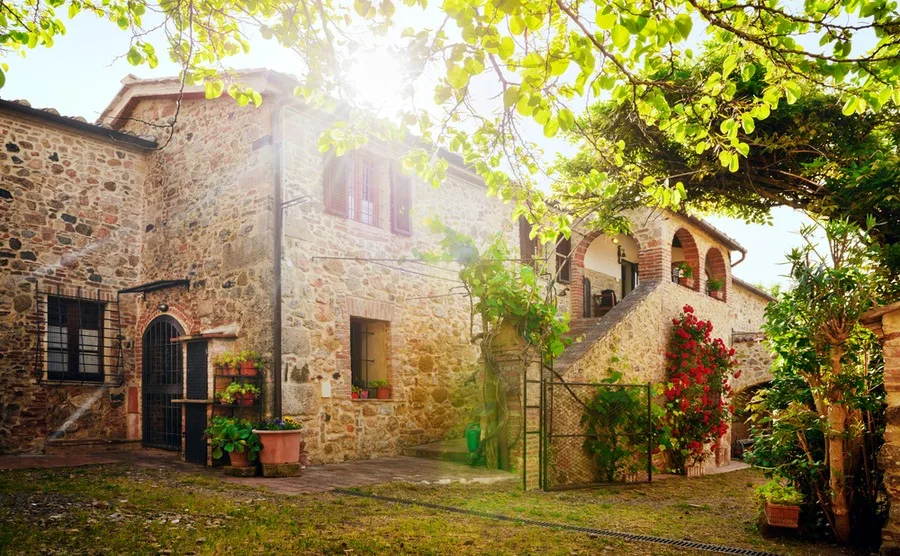
Traditional stone house in Tuscany
Lime mortar is used in most cases, which needs time to dry before you add more weight onto it. It’s a gradual process that requires the builder to select the best size of stone as they go along, and then chip or cut it to fit. The smoothest side of the stone to be seen on the inside and outside surfaces, and rubble and mortar fill the gap between the two. External stone walls can look beautiful when exposed and nicely pointed. Although in some cases, the stonework might not be that neat if the builder had originally intended to plaster it.
It’s usually recommended to plaster most of the internal walls, especially in bedrooms, as it lightens the room and gives it a cleaner look. Four walls of stone can be rather overpowering in a small space. However, one feature wall in stone adds character to a room, like wrinkles on a face!
Find stone houses for sale on our Italian property portal.
Building in the south
The cone shaped Trulli houses in Puglia are unique, not only for their quirky shape, but also because they were built without mortar. The story goes that being dry stone the farmers could dismantle them if the tax collector visited. These buildings need the stones to fit very neatly on top of each other, requiring very careful chipping. The cone section also needs to be perfectly angled to make it a stable structure.
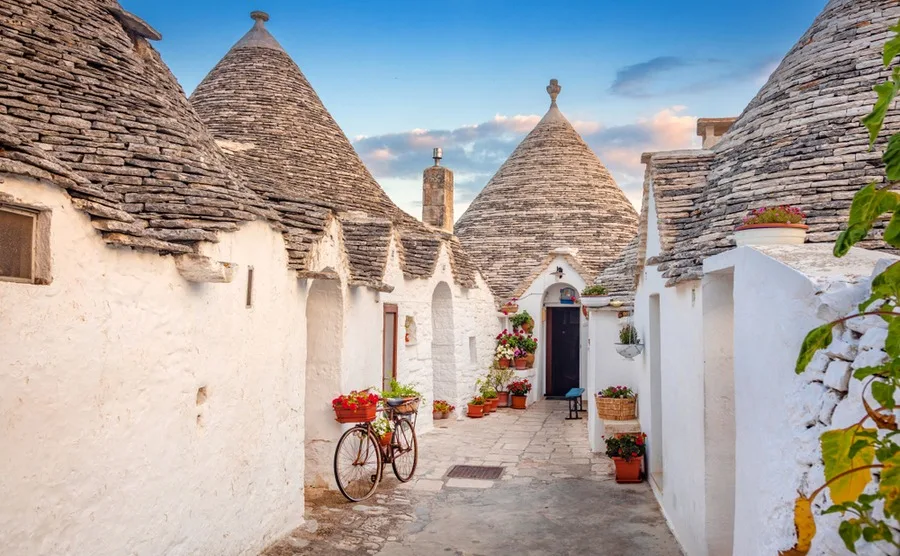
Cone-shaped Trulli
In the hot southern regions, it becomes important to design a house that will keep the cool air in and sun out. Stone is great for this, especially when combined with high vaulted ceilings, light coloured walls, verandas, shutters on windows with a through breeze, and a cellar room dug into the bedrock.
Family history
Many Italian stone houses have been standing for hundreds of years. When you step inside you can’t help but wonder what the walls have seen over the centuries: Nonna cooking over an open fire, grapes being pressed and put in barrels, pasta being made, and even the singing of folk songs.
Speaking of family, why not pool finances and buy your Italian property with your family? Explore our guide, Buying Abroad with Family.
Many stone houses have been beautifully renovated to reveal features that have been painted over, including vaulted ceilings, fireplaces and arches hidden under layers of plaster and paint. Some have been abandoned for many years, waiting for someone with energy and vision to bring them back to life. It is definitely worth the effort; it feels so rewarding to make them beautiful again, to be enjoyed for another hundred years.
Stone houses in Piedmont
In the region of Piedmont, there are hamlets in the mountains with beautiful stone houses. The roof stones can be quite thick and square here, whereas in the Aosta Valley they have fairly thin slices of stone, with a more rounded shape. These roofs are always in perfect harmony with the mountain, and blanketed in snow in the winter.
In Piedmont’s Langhe Hills, you’ll find large farmhouses with massive barns. In some areas the stone can have a hint of terracotta to its colour and is sometimes used alongside thin red bricks. Internal stone features can include stone-vaulted cellar ceilings, which I find amazing. How does all that weight stay up there?
The barns have the most amazing potential. They are huge, with large openings all along one side at the upper level, often with arches
Some farmhouses have the original terracotta tiled flooring in a mixture of square and rectangular shapes. Interestingly, it is the barns that have the most amazing potential. They are huge, with large openings all along one side at the upper level, often with arches. A good example is this one currently offered for sale on Property Guides for just €155,000. It’s a big renovation project, but has a lot of potential.
SEARCH homes in Piedmont easily on our property portal.
Stone houses in Tuscany
Like many other Italian regions, Tuscany is characterized by a great variety of landscapes: mountains, hills and vineyards, dotted with art cities, hill top towns, castles, villas and farm houses. That famous image of a tree-lined road winding up the hill to a farm house, is on many house buyers wish list.
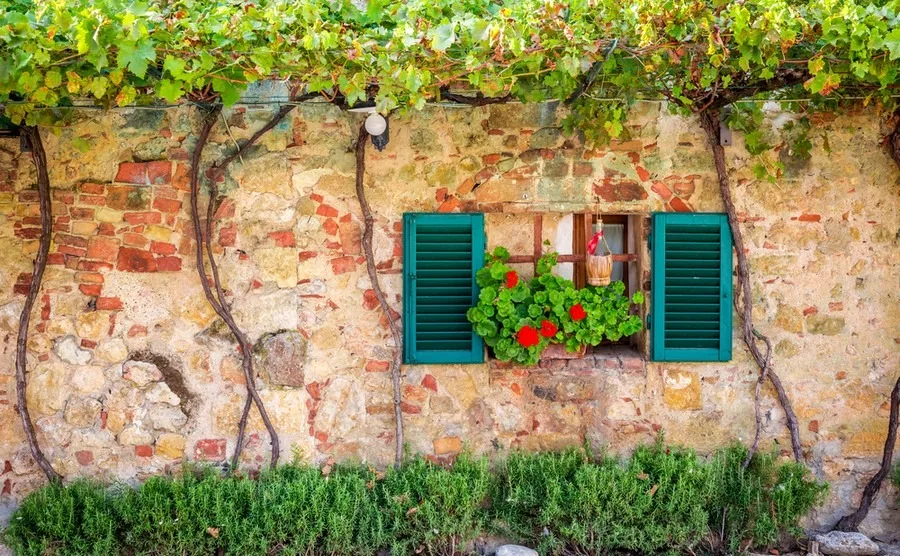
Your own vine too…
Each village and town has a unique identity due to the architectural influence and local construction materials available. The foot-hills of the Apennines, Florence, Pistoia, Arezzo and Cortona are known for their use of sandstone on buildings, whereas quartzites were widely used in Pisa and Lucca. Then, due to outcrops of clay near Siena and San Gimignanoare, red bricks began to be more widely used.
Check out some lovely and affordable Tuscan homes at our property pages.
Moving south of Florence, there is another type of natural stone that influenced the design of Tuscan villas. Travertine is a type of stone that first became popular in the 1400’s. It is a form of limestone deposited by mineral springs, especially hot springs. Its colour can be white, cream or tan. Most famously, it was used on the Colonnade of St. Peter’s Square in Rome and the Dome of St. Peters Basilica.
Although you wouldn’t build a whole house with it, marble should also get a mention here for its decorative use in homes. Among the most sort after is Carrara marble, which is white or blue-grey in colour. It is quarried from the Apuan Alps at Carrara, in northern Tuscany. The quarries are an amazing sight, making the mountain appear white with snow.
This property in Bagni di Lucca is a typical small stone house. The light shade of the pointing on the external stonework and the stone arched doorway add to its charm. Inside, the natural look is also reflected in the wooden beams. The property blends harmoniously into the surrounding landscape of mountains and woodland. With an asking price of €98,000, it’s a great little holiday home.
Find your dream stone built home in Tuscan here.
Floors in old stone houses
There are various materials used for flooring. Where available, terracotta tiles and wood are popular for first floors. In more luxurious properties, marble might be used; it is very popular for front steps, staircases and bathrooms. Lime is another good hardwearing flooring material. If you need to lift a stone floor in an old property, be prepared for the size and weight of the paving blocks. My own property has heavy stones that go as deep as 30cms and are very heavy.
You may also see cocciopesto floors, which are made with crushed brick mixed with sand and lime. In ancient times it was used by both the Phoenicians and the Etruscans, but it was the Romans who perfected its use. Cocciopesto is resistant to humidity so is useful in ground floor kitchens and bathrooms. It can also be used like a plaster for waterproofing walls and tanks. In the past, it was spread across domed roofs that have vaulted ceilings below them. It is similar to “Marmorino” which uses marble chips and dust instead of the crushed brick.
Ceilings
Many stone houses have wooden beams, between which you might see planks or flat tiles. In some cases, the wooden beams support brick barrel vaults, as seen in this house in Umbria.
If you are fortunate, you might find a property with a star, trough or barrel vaulted ceiling built entirely of stone. Sandstone blocks are perfect for these types of ceilings. They can be seen in the Masserie, Palazzi and villas of Puglia. An example is this wonderful villa with star vaulted ceiling, located near Lecce, for just €240,000. For more about Italian roofs and ceilings see my previous article “Italians take pride in the best roofs in the world”.
Unique stone houses of Puglia
The historic streets and courtyards of Puglia are often paved with limestone. Many of the buildings are built with either limestone or sandstone. Even those that are plastered and painted white are probably stone underneath. The coloured stone and whitewashed walls reflect the sun, and the high vaulted ceilings keep the rooms cool. Many flat roofs are also paved with stone slabs called “chianca” and coated with a modern water repellent.
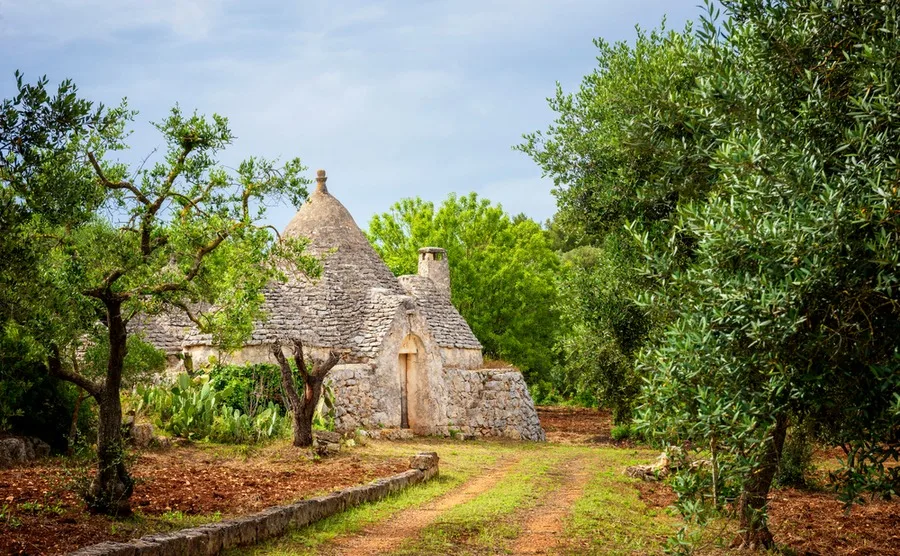
Typical Puglian stone houses include trulli and masserie
Typical Puglian stone houses include trulli and masserie. The trulli are the cone shaped rural buildings built with limestone, while the masserie are large fortified farmhouses built with tuffi and carpara. The sandstone blocks are perfect for building not only the walls, but also the vaulted ceilings. Other features can include fireplaces, arches and water cisterns dug into the rock.
Be ready for when travel restarts. Plan your viewing trip with the free Italian Viewing Trip Guide today.
Types of Puglia stone
Carpara
This sandstone is an excellent material for construction. It hardly absorbs any water, and after a while it becomes more waterproof with the formation of a superficial layer of lichen and efflorescence. It is quarried in coastal areas and can have a sunny orangey tone to it with a grainy texture. It was often used in the construction of rural buildings, such as “Lamia”.
Tuff
Like carpara, tuff can be cut into large tufi blocks for building. It is softer, allowing it to be cut with a saw. However, the presence of shells and fossils can affect the accuracy of the cuts. Being crumblier, you don’t get the sharp straight edges, like with the Leccese stone. It is yellowy white in colour.
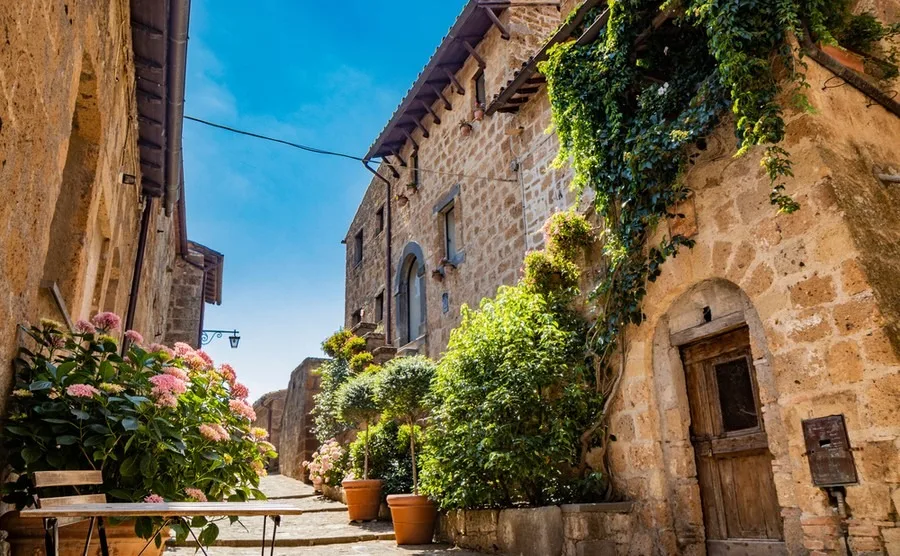
A medieval village with alleys and houses made from tuff and stone bricks
Pietra Leccese
This type of stone is well known on Salento houses, palaces and churches. White and straw yellow in colour, it is has a fine grain with the presence of clay, making it very compact. This smooth texture makes It perfect for carving. Famously used on the ornately carved baroque facades in Lecce, it’s also used on carved door surrounds, balconies, fire places and sculptures.
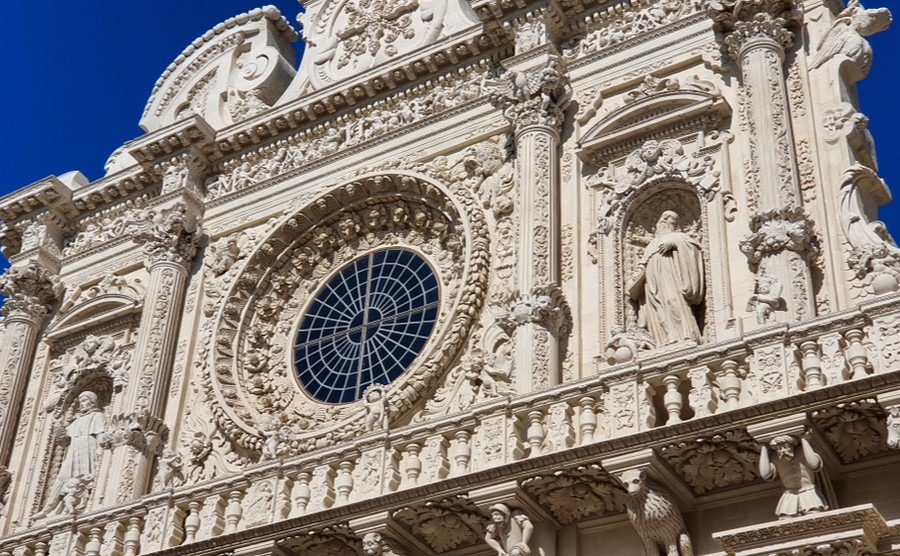
Carved Leccesse sandstone, pietra leccese, in Lecce, Puglia
There are still Master craftsmen in Puglia who can build trulli and vaulted ceilings. Take a look at this new villa in the Itria valley. It has both trough and barrel vaulted ceilings, made from tufi blocks. It’s a perfect example of how a stone house doesn’t have to be old fashion or rustic. Stone goes just as well with modern furnishings.
FIND stone houses for sale in Puglia.
Furnishing a stone house
Stone’s strength and soft colour tones can be matched with many styles of furniture, from shaker kitchens to modern white leather sofas. Furniture made from other strong materials, such as wood and metal, also work well alongside stone. Materials such as melamine can look a bit cheap and flimsy in comparison to the stone. A few “Made in Italy” pieces can go a long way to add that Italian touch, whether it’s furniture, a lamp, a painting or some ceramics. See “Italian Interior design” for more inspiration.
Benefits of a stone house
Natural stone performs well both inside and out, and is suitable for all weather conditions. Exposed stone walls need next to no maintenance. So no more house painting every spring. The thick walls also offer good protection and soundproofing, as well as conveying an appearance of strength and character.
Stone houses look beautiful and compliment their surroundings, especially in a natural landscape
It can be very reassuring to know that your home is fireproof and can’t be attacked by bugs. If your stone property is a castle, you may even be protected from invaders. More than anything, stone houses look beautiful and compliment their surroundings, especially in a natural landscape. In town, it is the carved stone doorways, balconies, and castles that remind us of our history and offer a sense of identity to the community. Stone houses are really worth cherishing for future generations.










